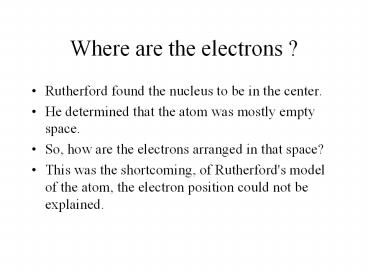Where are the electrons ? PowerPoint PPT Presentation
1 / 28
Title: Where are the electrons ?
1
Where are the electrons ?
- Rutherford found the nucleus to be in the center.
- He determined that the atom was mostly empty
space. - So, how are the electrons arranged in that space?
- This was the shortcoming, of Rutherford's model
of the atom, the electron position could not be
explained.
2
What is the electromagnetic spectrum?
- brainstorm
3
Electromagnetic radiation
- Is a form of energy that exhibits wavelike
behavior as it travels through space. - Electromagnetic spectrum all the forms of
electromagnetic radiation.
4
Electromagnetic spectrum
5
Electromagnetic spectrum
- Each line on the spectrum represents a certain
wave frequency of radiation. - Each wave frequency is associated with a certain
amount of energy.
6
Electromagnetic spectrum
- The elecromagnetic spectrum includes all
forms of radiation, one of which is visible light
-- the radiation to which our eyes are sensitive.
- Gamma-rays, X-rays, ultraviolet,
infrared and radio waves are also forms of
radiation. We divide the spectrum up according to
the wavelength of the radiation.
7
Electromagnetic spectrum
8
Electromagnetic spectrum
9
A wave is described by
- Wavelength - the distance between corresponding
points on adjacent waves - Frequency- the number of waves that pass a given
point in a specific time, usually one second.
Unit is the hertz, (Hz). - http//www.colorado.edu/physics/2000/waves_particl
es/
10
Wave description
- Mathematically c speed 3 x108 m/s
- Speed of light frequency x wavelength
- Since c is constant
- Frequency is inversely proportional to
wavelength - All three, speed, wavelength, frequency are
related
11
example
- What is the frequency of a wave that has a
wavelength of 200 nm? - 3 x 108/ 200 nm
12
1900s
- Wave model of light was accepted
13
Early 1900s Photoelectric experiments
- Experiment - Planck
- Photoelectric effect refers to the emission of
electrons from a metal when light shines on the
metal. - Shined light on a metal varying the frequency of
the light. Below a certain frequency the
electrons were not emitted. - When the frequency was high enough there was
enough energy to knock electrons loose from the
metal.
14
Quantum
- Planck suggested that an object emits energy in
little packets of energy called a quantum. - Quantum minimum quantity of energy that can be
lost or gained by an electron. - Energy that is given off is related to wave
frequency.
15
Go to
- http//www.colorado.edu/physics/2000/quantumzone/l
ines2.html - http//www.colorado.edu/physics/2000/waves_particl
es/
16
Planck in other words.
- Proposed that there is a fundamental restriction
on the amount of energy that an object emits or
absorbs each piece of energy is a quantum. - E hv
- h 6.6262 x 10-34 Js
- v the frequency of the wave
17
Dual wave-particle nature of light
- Einstein expanded on Plancks theory and said
that electromagnetic radiation has a dual
wave-particle nature. - While light exhibits wave like properties, it can
also be thought of as a stream of particles. - Each particle carries a quantum of energy these
particles are called photons.
18
Vocab
- Photon particle of electromagnetic radiation
having zero mass and carrying a quantum of
energy. - Ephoton hv
- Quantum the minimum quantity of energy that can
be gained or lost by an electron.
19
Photoelectric effect explained
- Electromagnetic radiation is only absorbed in
whole number of photons. - In order for an electron to be bumped off, it
must be struck by a photon of a certain minimal
amount of energy. - The minimal energy corresponds to a minimal
frequency
20
continued
- Different metals require energy at different
frequencies to exhibit a photoelectric effect. - Each metal has a certain required minimal level
of energy required for the electrons to be
knocked loose.
21
Ground state
- The lowest possible energy level
- Close to the nucleus
- The lowest energy state of an atom
22
Excited state
- When an atom absorbs energy and the electrons
move to a higher energy level. - An atom has a higher potential energy than its
ground state.
23
Like a ladder
- Energy levels are like the rungs on a ladder, you
can not step between the rungs. Electrons must
jump from level to level, they can not reside
between the levels
24
electrons
- When an electron gains enough energy it jumps up
an energy level ( rung on a ladder), and becomes
excited. - It then immediately returns to its ground state.
- The energy is released as a particular wavelength
that corresponds to a particular color. A photon
of radiation.
25
Line emission spectra
- The spectra given off by the electrons of a
certain element. - Each spectra is unique to the element or
compound. - Line spectra are used to identify elements and/or
compounds
26
Line emission spectra
- The fact that specific frequencies are emitted
indicates that the energy differences between an
atoms energy states are fixed - Each line on the spectra represents a photon of
energy.
27
Bohr model of atom
- The electron circles the nucleus in an orbital.
- When the electron gains enough energy ( a certain
photon) it jumps to a higher level orbital. - When it returns to ground state it emits the
energy (photon). The frequency of the photon is
seen in the spectra.
28
Bohr successfully calculated the hydrogen line
spectra
- Bohrs model of the hydrogen atom accounted
mathematically for the energy of each of the
transitions of the Lyman, Balmer and Paschen
spectral series. - Bottom line Bohrs model of the H atom, with
the line spectra, could be mathematically
supported. - summary and beyond

